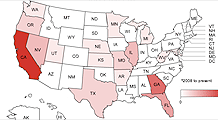Regional banks can't catch a break
Souring loan portfolios and dividend payments to the government for TARP funds are putting pressure on banks like Comerica, KeyCorp and SunTrust.
NEW YORK (CNNMoney.com) -- Even in this chilly economic climate, megabanks like Wells Fargo and Citigroup have somehow managed to make money.
A bit lower on the banking food chain however, there have been few signs of relief for big regional banks.
KeyCorp (KEY, Fortune 500) and Fifth Third Bancorp (FITB, Fortune 500), two major banks headquartered in Ohio, both reported losses this week, hurt, in part, by their exposure to commercial real estate.
Further to the south, First Horizon National (FHN), one of Tennessee's largest lenders, recorded its fourth-straight loss last week. Atlanta-based SunTrust (STI, Fortune 500) reported an $875.4 million loss on Thursday.
And in other states that have been hit hard during the recession, such as Oregon, regional banks have found themselves unable to catch a break. Portland-based Umpqua Holdings reported a nearly $14 million loss last week.
Many of these regional banks have been stung by rising loan losses as more and more Americans find themselves out of work or simply unable to make ends meet.
The latest boom in mortgage refinancing activity helped some regional banks this quarter, but much of those spoils went to the industry giants, including firms like JPMorgan Chase and Bank of America, which boast substantially larger mortgage portfolios than the regional banks.
At the same time, smaller lenders, which tend to focus on the bread-and-butter business of taking in deposits and lending money back out, didn't enjoy the recent uptick in corporate bond underwriting and trading activity that many of the top banks did this quarter, notes Peter Winter, managing director at BMO Capital Markets.
"The regional banks are more representative of the general economy," he said.
Bank results overall would also have looked a bit better had it not been for the quarterly dividend payments related to accepting government funds under the Troubled Asset Relief Program, or TARP.
Consider the case of Dallas-based Comerica (CMA). Earlier this week, the company reported a first-quarter net loss applicable to common stock of $24 million. Had the company not had to pay $33 million in preferred dividends to the Treasury Department, the company maintains it would have been profitable for the quarter. Comerica took $2.25 billion as part of the TARP program.
Of course, there were some bright spots this quarter within the regional bank group. Companies like U.S. Bancorp (USB, Fortune 500) and Pittsburgh-based PNC (PNC, Fortune 500) both reported profits for the quarter that exceeded analysts' expectations.
At the same time, credit costs moderated at some regional lenders as some banks scaled back on adding to their loan loss reserves after acting aggressively last quarter.
But what troubles banking executives and analysts is how the next couple quarters will shake out.
Non-performing assets, or loans that are not collecting interest or principal payments, continued to climb in the latest quarter. That's likely to be something regulators are looking at closely as they conduct stress tests of the nation's 19 largest banks -- a group that includes several of the bigger regional banks.
In addition, there are increasing signs of trouble in areas such as commercial real estate as well as commercial and industrial loans, two asset classes that regional banks rely heavily on in their lending business, notes Sandler O'Neill's Kevin Fitzsimmons, who tracks many banks located in the Southeast.
"We're not yet seeing a big spike," he said. "But it is something investors are bracing themselves for." ![]()


